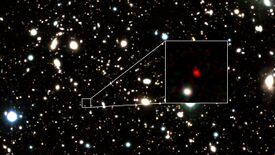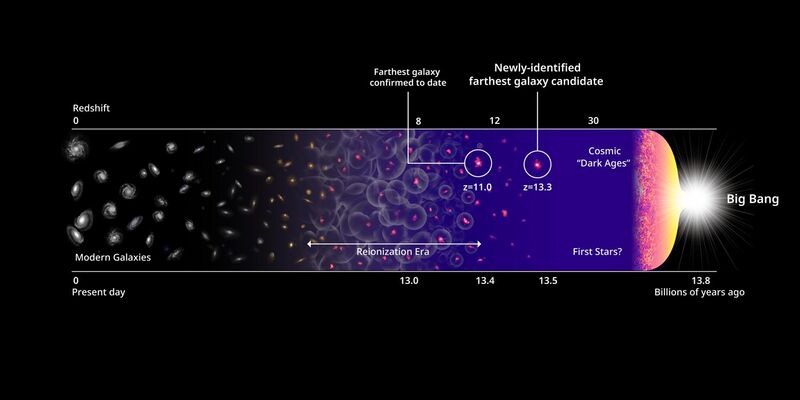Astronomy:HD1 (galaxy)
| HD1 | |
|---|---|
 Three-color image of HD1, the most distant galaxy candidate to date (13.5 billion light years), created using data from the VISTA telescope in Paranal Observatory. The red object in the center of the zoom-in image is HD1.[1] | |
| Observation data (J2000 epoch) | |
| Constellation | Sextans[2][3] |
| Right ascension | 10h 01m 51.31s[2] |
| Declination | 02° 32′ 50.0″[2] |
| Redshift | 13.27[2] |
| Distance | |
HD1 is a proposed high-redshift galaxy, which is considered (as of April 2022) to be one of the earliest and most distant known galaxies yet identified in the observable universe. The galaxy, with an estimated redshift of approximately z = 13.27, is seen as it was about 324 million years after the Big Bang, 13.787 billion years ago.[6] It has a light-travel distance (lookback time) of 13.463 billion light-years from Earth, and, due to the expansion of the universe, a present proper distance of 33.288 billion light-years.[5]
Discovery
The discovery of the proposed high-redshift galaxy HD1 (RA:10:01:51.31 DEC:+02:32:50.0) in the Sextans constellation,[2][3] along with another high-redshift galaxy, HD2 (RA:02:18:52.44 DEC:-05:08:36.1) in the Cetus constellation,[2][3] was reported by astronomers at the University of Tokyo on 7 April 2022. These two galaxies were found in two patches of sky surveyed by the Cosmic Evolution Survey and by the Subaru Telescope in the Subaru/XMM-Newton Deep Survey Field respectively. They were found by looking for objects that are much brighter in the so-called K band of infrared than in the H band (around 1.6 microns), which could indicate a Lyman-break galaxy red-shifted by a factor of around 13. For this reason they were named "HD 1" and "HD 2" (for "H band dropout", not to be confused with stars HD 1 and HD 2 in the Henry Draper Catalog.[2]
Physical properties
HD1 is one of the earliest and most distant known galaxies yet identified in the observable universe, having a spectroscopic redshift of z = 13.27, meaning that the light from the galaxy travelled for 13.5 billion years on its way to Earth, which due to the expansion of the universe, corresponds to a proper distance of approximately 33.4 billion light-years (10.2 billion parsecs).[1][2][4][7][8][9] The observed position of HD1 was determined to be about 330 million years after the Big Bang.[10] Another similar high-redshift galaxy, HD2, was determined to be nearly as far away as HD1.[11]
HD1's unusually high brightness has been an open question for its discoverers; it has a significantly more luminous ultraviolet emission than similar galaxies at its redshift range. Possible explanations have been proposed, one being that it is an active Lyman-break galaxy, or a rather extreme starburst galaxy producing stars at a rate far higher than any previously observed. It is also considered that it may have a significant population of Population III stars that are far more massive and luminous than present-day stars.[12] Another scenario is that it may be a quasar hosting a supermassive black hole; such a scenario would put constraints on models of black hole growth in such an early stage of the universe. A resolution to the true nature of the galaxy would likely await confirmations from the James Webb Space Telescope.[13]
The previous farthest known galaxy, GN-z11, discovered in 2015, had a redshift of 11, suggesting that the observed position of the galaxy is about 420 million years after the Big Bang.[11]
Future considerations
According to the discoverers of HD1 and HD2, "If spectroscopically confirmed, these two sources [ie, HD1 and HD2] will represent a remarkable laboratory to study the Universe at previously inaccessible redshifts."[7] The researchers expect even further clarification of the astronomical objects, including better identifying the objects as galaxies, or, possibly as quasars or black holes, when carefully examined by the James Webb Space Telescope, Nancy Grace Roman Space Telescope, and GREX-PLUS space missions.[2] HD1, on close examination, may also reveal the first visible Population III stars, due to its very early age.[13] In addition, the researchers claim that the use of the new upcoming space telescopes could help discover over 10,000 galaxies at this early epoch of the Universe.[11]

[Compare: Nature timeline - History of the Universe (linear scale)]
See also
- CEERS-93316
- Earliest galaxies
- GLASS-z12
- List of galaxies
- List of the most distant astronomical objects
References
- ↑ 1.0 1.1 1.2 Lira, Nicolás; Iono, Daisuke; Oliver, Amy c.; Ferreira, Bárbara (7 April 2022). "Astronomers Detect Most Distant Galaxy Candidate Yet". Atacama Large Millimeter Array. https://www.almaobservatory.org/en/press-releases/astronomers-detect-most-distant-galaxy-candidate-yet/. Retrieved 8 April 2022.
- ↑ 2.0 2.1 2.2 2.3 2.4 2.5 2.6 2.7 2.8 Harikane, Yuichi (2 February 2022). "A Search for H-Dropout Lyman Break Galaxies at z ∼ 12–16". The Astrophysical Journal 929 (1): 1. doi:10.3847/1538-4357/ac53a9. Bibcode: 2022ApJ...929....1H.
- ↑ 3.0 3.1 3.2 Staff (2008). "Finding the constellation which contains given sky coordinates". DJM.cc. http://djm.cc/constellation.html. Retrieved 8 April 2022.
- ↑ 4.0 4.1 4.2 Crane, Leah (7 April 2022). "Astronomers have found what may be the most distant galaxy ever seen – A galaxy called HD1 appears to be about 33.4 billion light years away, making it the most distant object ever seen – and its extreme brightness is puzzling researchers". New Scientist. https://www.newscientist.com/article/2315330-astronomers-have-found-what-may-be-the-most-distant-galaxy-ever-seen/. Retrieved 8 April 2022.
- ↑ 5.0 5.1 Kempner, Joshua (2022). "KEMPNER Cosmology Calculator". Kempner.net. https://www.kempner.net/cosmic.php. Retrieved 6 August 2022. KEMP Cosmology Calculator - Set H0=67.4 and OmegaM=0.315 (see Table/Planck2018 at "Lambda-CDM model")
- ↑ Planck Collaboration (2020). "Planck 2018 results. VI. Cosmological parameters". Astronomy & Astrophysics 641: page A6 (see PDF page 15, Table 2: "Age/Gyr", last column). doi:10.1051/0004-6361/201833910. Bibcode: 2020A&A...641A...6P.
- ↑ 7.0 7.1 Pacucci, Fabio (7 April 2022). "Are the newly-discovered z ∼ 13 drop-out sources starburst galaxies or quasars?". Monthly Notices of the Royal Astronomical Society 514: L6–L10. doi:10.1093/mnrasl/slac035. https://academic.oup.com/mnrasl/advance-article-abstract/doi/10.1093/mnrasl/slac035/6564647. Retrieved 7 April 2022.
- ↑ Buongiorno, Caitlyn (7 April 2022). "Astronomers discover the most distant galaxy yet - Unusually bright in ultraviolet light, HD1 may also set another cosmic record.". Astronomy. https://astronomy.com/news/2022/04/researchers-discover-the-most-distant-galaxy-yet. Retrieved 7 April 2022.
- ↑ Wenz, John (7 April 2022). "Behold! Astronomers May Have Discovered The Most Distant Galaxy Ever – HD1 could be from just 300 million years after the Big Bang.". Inverse. https://www.inverse.com/science/most-distant-galaxy-discovery. Retrieved 7 April 2022.
- ↑ Carter, Jamie (7 April 2022). "Meet HD1, The New Most Distant Galaxy Found 13.5 Billion Years Back In Time And Close To The 'Big Bang'". Forbes. https://www.forbes.com/sites/jamiecartereurope/2022/04/07/meet-hd1-the-new-most-distant-galaxy-found-135-billion-years-back-in-time-and-close-to-the-big-bang/. Retrieved 10 April 2022.
- ↑ 11.0 11.1 11.2 Carlisle, Camille M. (7 April 2022). "Are These The Most Distant Galaxies Yet Seen? – Two fuzzy red objects in the early universe may be galaxies shining at us from only a few hundred million years after the Big Bang.". Sky & Telescope. https://skyandtelescope.org/astronomy-news/are-these-the-most-distant-galaxies-yet-seen/. Retrieved 7 April 2022.
- ↑ BBC News Staff (10 April 2022). "Astronomers spot oldest and most distant galaxy, new study claims". BBC News. https://www.bbc.co.uk/newsround/61035215. Retrieved 10 April 2022.
- ↑ 13.0 13.1 Overbye, Dennis (7 April 2022). "Astronomers Find What Might Be the Most Distant Galaxy Yet – Is the object a galaxy of primordial stars or a black hole knocking on the door of time? The Webb space telescope may help answer that question.". The New York Times. https://www.nytimes.com/2022/04/07/science/astronomers-distant-galaxy.html. Retrieved 7 April 2022.
External links
Coordinates: ![]() 10h 01m 51.31s, +02° 32′ 36.1″
10h 01m 51.31s, +02° 32′ 36.1″

